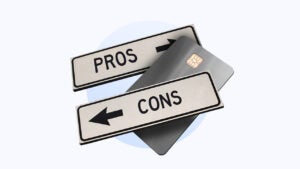Should you get a bank account from your credit card issuer?

American Express, Capital One and Discover are best known as credit card issuers, but all three also offer compelling savings rates, sitting at 4.25 percent APY as of June 2024. That’s still below the highest savings rate on offer today — 5.55 percent APY from MyBankingDirect — but it contrasts sharply with the four largest U.S.-based banks, which have robust credit card offerings and measly savings yields.
At Bank of America, Chase and Wells Fargo, for example, the typical savings account earns just 0.01 percent. Citibank pays a slightly higher 0.03 percent (all deposit accounts mentioned in this article are federally-insured up to the standard limits of $250,000 per depositor per ownership category).
To be fair, these big banks offer some advantages, such as in-person customer service, broader product offerings and extensive ATM networks. If local availability matters to you, American Express, Capital One and Discover aren’t likely to be on your radar. Neither American Express nor Discover operate physical branches, and Capital One’s 280 retail bank branches represent just 6 percent of Chase’s 4,700-branch footprint.
However, I’d venture to guess that many people don’t even know that American Express, Capital One and Discover offer savings accounts — let alone compelling ones. Here’s when it makes sense to consider these offerings, as well as situations where alternative arrangements may be more appealing.
When it pays to mix and match
Generally speaking, you can get the best of both worlds by mixing and matching different products from various financial institutions. For example, even if you keep your existing checking account and link it to a high-yield online savings account at a new bank, you’ll be able to keep all of your direct deposits and automatic bill payments in place while also increasing your savings APY. In most cases, it’s easy to move money back and forth as needed, often within a business day or two.
Since savings accounts don’t tend to offer many bells and whistles, it’s best to look for a good rate and easy access. Solid customer service is a nice bonus — and it’s worth noting that American Express and Discover traditionally dominate the J.D. Power Credit Card Satisfaction Study.
Loyalty pays off at Bank of America
However, some credit card issuers offer special incentives to consumers who combine their credit cards with a deposit account. Bank of America falls into this category, not because of its deposit rates, but because of the Bank of America Preferred Rewards program, which breaks down into the following tiers:
- Gold tier: If you have between $20,000 and $49,999 in Bank of America deposit accounts and/or eligible investment accounts with its subsidiary Merrill Lynch, you qualify for the program’s Gold tier. This enables you to earn 25 percent more on select Bank of America credit card rewards, among other perks.
- Platinum tier: At the Platinum tier ($50,000 to $99,999 in eligible balances), you’ll enjoy a 50 percent credit card rewards bonus.
- Platinum Honors, Diamond and Diamond Honors tiers: With the Platinum Honors ($100,000 to $999,999 in eligible balances), Diamond ($1,000,000 to $9,999,999 in eligible balances) and Diamond Honors (at least $10,000,000 in eligible balances) members get 75 percent more credit card rewards, as well as additional benefits such as rate reductions on other products (including mortgages, home equity lines of credit and auto loans), foreign currency discounts, ATM fee waivers and more.
With a 75 percent bonus, even a relatively pedestrian 1.5 percent cash back card like the Bank of AmericaⓇ Unlimited Cash Rewards credit card could jump to the top of the list of the best cash back credit cards with an effective 2.625 percent return.
It’s also worth noting that, while Bank of America doesn’t offer compelling checking or savings yields, its CD rates are much more competitive, and its Merrill Lynch investment accounts are good options for those looking to invest in stocks and bonds.
When it makes sense to pair a checking account with a credit card
At Alliant Credit Union, you’ll need a checking account with the organization to open the lucrative Alliant Cashback VisaⓇ Signature Card*. That card is near the very top of the cash back universe with a 2.5 percent rebate on up to $10,000 in purchases each monthly billing cycle (1.5 percent back after that). Alliant’s checking account doesn’t have a minimum balance requirement, so you don’t necessarily need to make this your primary checking account and upend your existing setup to take advantage of the card’s rewards.
Checking accounts often come with debit cards, but debit card rewards became scarce after the Durbin Amendment capped debit card interchange fees in 2010. American Express and Discover still offer some debit card rewards, although they still pale in comparison with most credit cards.
Amex’s rewards checking account, for example, yields 1 percent on deposits and doles out 1 Membership Rewards point for every $2 spent. Each one of those points is worth 2 cents, according to our points valuations, so that’s akin to a 1 percent rewards ratio. Discover doesn’t pay interest on its checking account, but the account’s debit card gives 1 percent cash back (up to $3,000 in monthly purchases).
It’s also worth noting that, from June 3 through July 31, 2024, American Express is giving its new and existing debit cardholders 4 Membership Rewards points for every $2 spent.
Other perks when consolidating accounts
Beyond enhanced rewards, anecdotal reports suggest that holding other accounts with a bank when trying to apply for their credit cards can lead to better approval odds.
Another instance in which you might want to pair a bank account and a credit card from the same financial institution is if you make frequent payments. Earlier this year, I ran into a problem with my Wells Fargo credit card when I used the card a lot in quick succession and tried to pay down my balance — only to learn that external checking accounts are limited to four Wells Fargo credit card payments per month.
The bottom line
Sometimes loyalty pays, and sometimes it’s better to mix and match different accounts from different financial institutions. It’s important to consider your specific circumstances and evaluate how much complexity you’re willing to take on. At the very least, don’t be among the two-thirds of savers earning less than 4 percent when there are much better options out there.
Have a question about credit cards? E-mail me at ted.rossman@bankrate.com and I’d be happy to help.
The information about the Alliant Cashback VisaⓇ Signature Card has been collected independently by Bankrate. The card details have not been reviewed or approved by the issuer.






